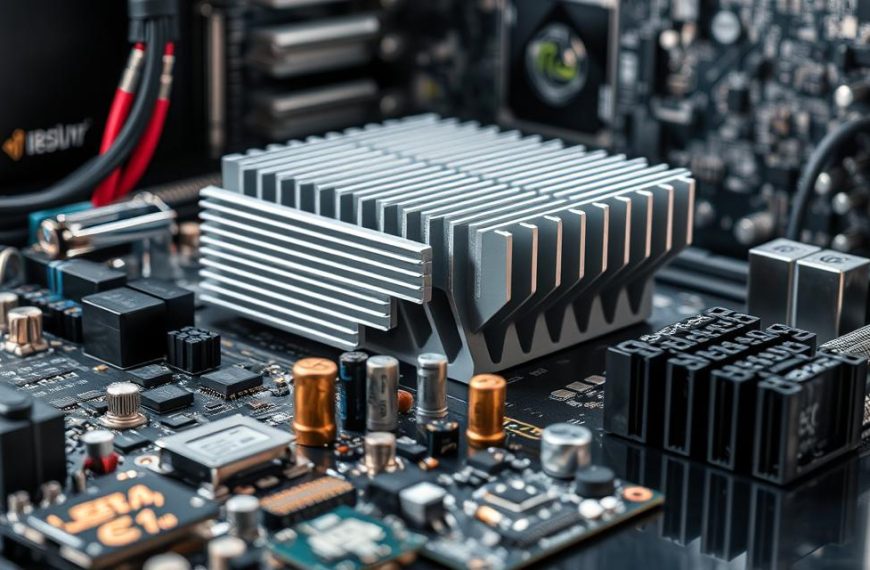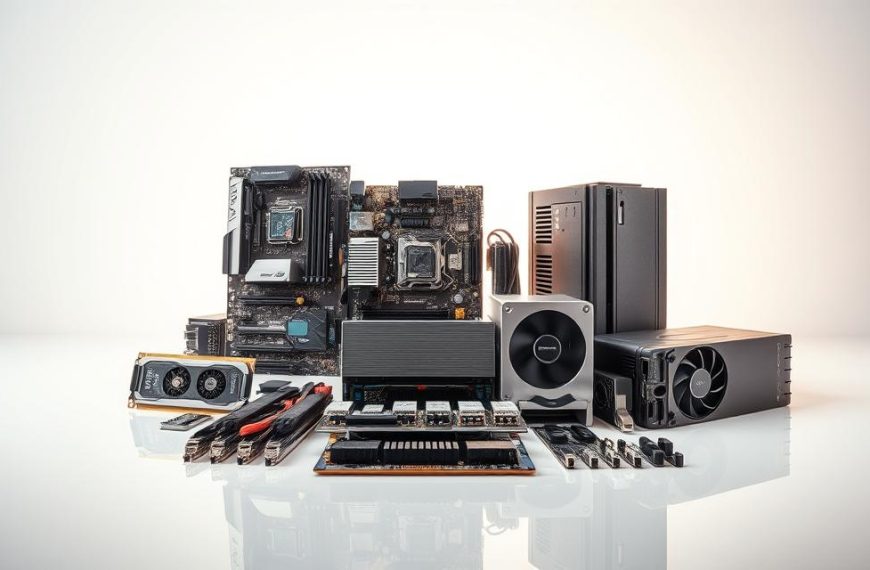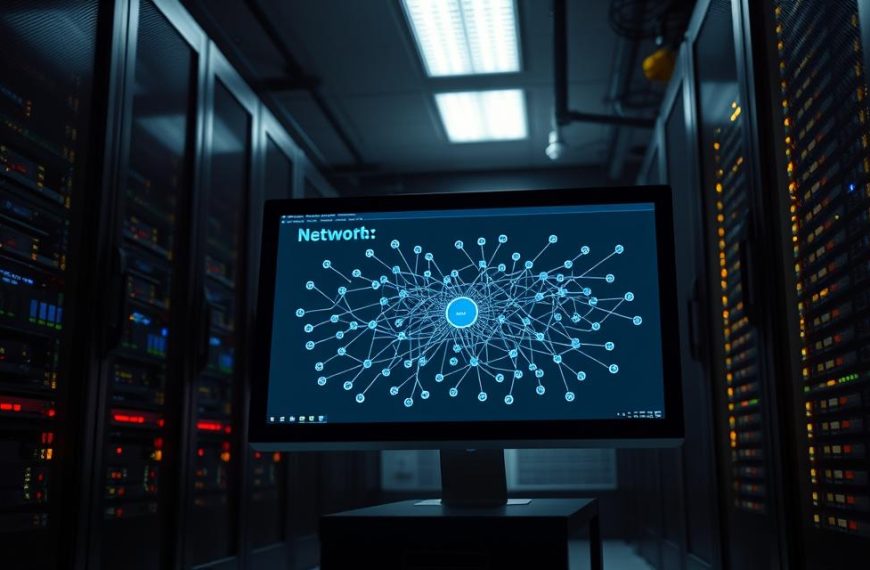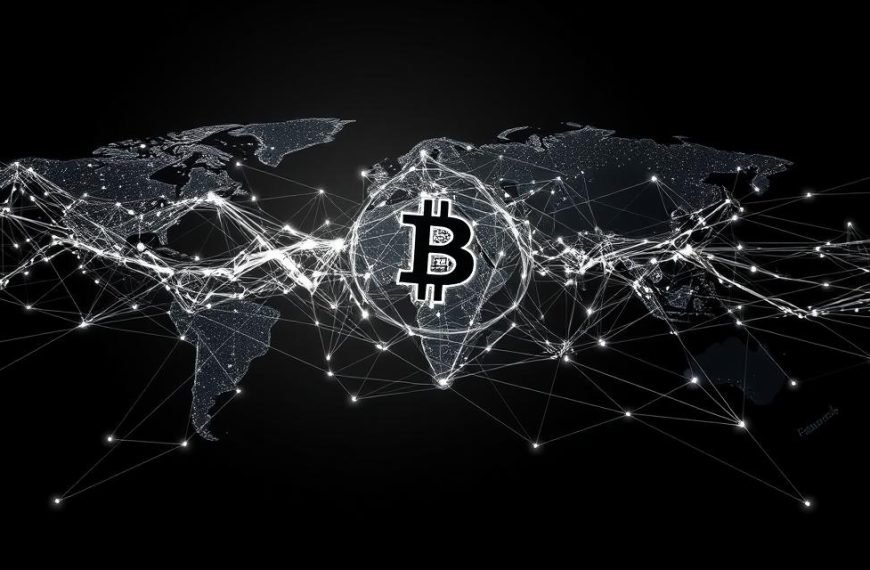A worldwide computer network connects millions of devices globally. It enables seamless communication and resource sharing across private, public, academic, and government systems. This interconnected framework relies on standardized protocols like TCP/IP to ensure smooth data transfer.
With over 5.35 billion users in 2024, this network has become essential for modern life. It powers internet service, allowing people to access information and services effortlessly. The Internet and the World Wide Web are often confused, but they serve distinct purposes. The Internet is the infrastructure, while the Web is a service built on it.
Key components include hardware, communication protocols, and service providers. Organizations like ICANN and IETF oversee its governance, ensuring stability and growth. Since the 1990s, this network has expanded exponentially, transforming how we live and work.
Introduction to a Worldwide Computer Network
Interconnected systems form the foundation of today’s digital communication. These systems, often referred to as the Internet, rely on standardized protocols like TCP/IP to ensure seamless data transfer. This global framework combines private and public networks through electronic, wireless, and optical technologies.
Services such as the World Wide Web, email, VoIP, and file sharing are powered by this vast system. It’s more than just a collection of devices; it’s a complex web of connections that enables instant communication and resource sharing.
The origins of this system trace back to ARPANET, a four-node network established in 1969. Over the decades, advancements like packet switching, fiber optics, and wireless communication have propelled its growth. Today, over 100,000 km of submarine cables form the backbone of this infrastructure.
Here are some key facts about its current scale:
- Over 350 billion emails are sent daily.
- Google processes approximately 5 billion searches every day.
This system has become indispensable, shaping how we live, work, and connect. Its evolution continues to redefine the boundaries of technology and communication.
The Evolution of Computer Networks
Modern digital connectivity traces its roots to groundbreaking innovations in the mid-20th century. Early experiments with *packet switching* and military projects paved the way for today’s seamless data exchange. This section explores pivotal moments that shaped global communication.
Early Developments in Networking
The 1950s SAGE system marked the first large-scale attempt to link computers for real-time data sharing. Independent work by Paul Baran and Donald Davies refined *packet switching*, a method critical for efficient routing. By 1969, ARPANET connected four U.S. universities, proving decentralized network viability.
The Birth of the Internet
In 1974, Vint Cerf and Bob Kahn published TCP/IP specifications, creating a universal protocol. NSFNET’s 1983 deployment expanded access beyond military and academic circles. Key 1980s milestones included email standardization and DNS adoption, streamlining user interactions.
The 1991 launch of CERN’s World Wide Web democratized information access. By 1995, full commercialization began after NSFNET’s decommission, unleashing the Internet’s economic potential.
Key Components of a Worldwide Computer Network
The backbone of global connectivity lies in its essential components. These include both physical and digital elements that work together to ensure seamless communication. Understanding these parts is crucial for grasping how data moves across systems.
Hardware: Routers, Switches, and Cables
Physical components like routers, switches, and cables form the foundation of any system. Routers direct data packets between devices, while switches connect multiple devices within a local area. Cables, including fiber optic and Cat 8, ensure high-speed transmission.
Submarine cables carry 99% of international data, showcasing their importance. Innovations like OM4 fiber and 5G mmWave continue to push the boundaries of speed and efficiency.
Software: Protocols and Applications
On the digital side, software plays a critical role. Protocols like TCP/IP and HTTP/3 govern how data is exchanged. Emerging standards like QUIC and MQTT are tailored for modern needs, such as IoT integration.
Network interface cards (NICs) and BGP routing tables manage over 900,000 IPv4 routes. SDN controllers are replacing traditional systems, offering more flexibility and control.
Together, these hardware and software elements create a robust framework for global communication. Their evolution continues to shape the future of connectivity.
How a Worldwide Computer Network Functions
The seamless operation of global connectivity relies on intricate processes and systems. These systems ensure efficient data transfer, smooth transmission, and reliable connections across vast distances. Two critical aspects of this functionality are data transmission and the role of service providers.
Data Transmission and Packet Switching
Modern data exchange depends on packet switching, a method that breaks information into smaller packets for efficient routing. These packets travel through multiple nodes, ensuring faster and more reliable transmission. The OSI model, with its seven layers, governs this process, from physical cables to application-level interactions.
Average packet round-trip times (RTT) vary by distance: 45ms for continental traffic and 250ms for intercontinental traffic. Innovations like IPv6 adoption, currently at 34%, address IPv4 exhaustion, ensuring scalability for future needs.
Role of Internet Service Providers (ISPs)
Service providers play a vital role in maintaining global connectivity. Tier 1 ISPs like Lumen, AT&T, and Deutsche Telekom form the backbone of this system. They establish peering agreements with Tier 2 and Tier 3 providers, ensuring seamless connections across regions.
Content Delivery Networks (CDNs) like Akamai and Cloudflare optimize traffic by caching data closer to users. Net neutrality regulations also impact how ISPs manage bandwidth, ensuring fair access for all users.
| Component | Function | Example |
|---|---|---|
| Packet Switching | Breaks data into packets for efficient routing | OSI Model Layers |
| ISPs | Provide connectivity and manage traffic | Lumen, AT&T |
| CDNs | Optimize data delivery | Akamai, Cloudflare |
Types of Computer Networks
Different types of systems enable communication across various scales, from small offices to global infrastructures. These systems are categorized based on their size, range, and purpose. Understanding their differences helps in choosing the right setup for specific needs.
Local Area Network (LAN) vs. Wide Area Network (WAN)
A local area network (LAN) connects devices within a limited area, like an office or home. It offers high speeds, ranging from 1Gbps to 100Gbps, making it ideal for fast data transfer. LANs are cost-effective and easy to manage for small-scale connections.
In contrast, a wide area network (WAN) covers larger geographical areas, linking multiple LANs. WAN speeds typically range from 10Mbps to 100Gbps. SD-WAN adoption is growing at a 34% CAGR, offering flexibility and cost savings. 5G WAN implementations now achieve latencies below 10ms, enhancing performance.
Global Area Network (GAN) and the Internet
A global area network (GAN) spans multiple countries, often using satellite or submarine cables. Transatlantic pings average 65ms, while satellite latency can reach 500ms. Emerging LEO satellite networks, like Starlink and Project Kuiper, aim to reduce these delays.
The internet is the largest GAN, connecting billions of devices worldwide. Edge computing is reshaping its topology, bringing data processing closer to users. IoT devices are projected to reach 29 billion by 2030, further expanding its scope.
| Type | Range | Speed | Use Case |
|---|---|---|---|
| LAN | Local | 1Gbps-100Gbps | Offices, Homes |
| WAN | Regional | 10Mbps-100Gbps | Businesses, ISPs |
| GAN | Global | Varies | Internet, IoT |
The Role of Protocols in Networking
Protocols are the unsung heroes of modern digital communication. They define the rules for how data is transmitted, ensuring seamless connectivity across systems. Without these standardized guidelines, the network would struggle to function efficiently.
These rules govern everything from routing to security, making them essential for reliable communication. From the widely used TCP/IP to emerging standards like QUIC, protocols shape the backbone of the Internet.
TCP/IP: The Backbone of the Internet
TCP/IP is the foundation of modern connectivity. It handles 95% of Internet traffic, ensuring reliable data delivery. This protocol suite divides information into packets, routes them efficiently, and reassembles them at the destination.
Its robustness lies in its layered approach. The TCP layer ensures accurate transmission, while the IP layer manages addressing and routing. Together, they create a scalable and reliable framework for global communication.
Other Essential Networking Protocols
Beyond TCP/IP, several protocols play critical roles. QUIC, for instance, carries 75% of Chrome traffic in 2024. It reduces latency by combining encryption and transmission into a single step.
HTTP/3, built on QUIC, offers faster performance for web applications. IPv6, with its simplified header structure, addresses the limitations of IPv4. Emerging protocols like SRv6 and MPLS-TP are tailored for advanced network needs.
However, protocols are not without vulnerabilities. DNS spoofing and TCP SYN floods remain significant threats. Implementing security measures like RPKI can mitigate risks like BGP hijacking.
| Protocol | Function | Example |
|---|---|---|
| TCP/IP | Ensures reliable data delivery | Internet backbone |
| QUIC | Reduces latency | Chrome traffic |
| IPv6 | Simplifies addressing | Replaces IPv4 |
| HTTP/3 | Improves web performance | Built on QUIC |
Network Topologies and Their Significance
The structure of a network plays a crucial role in its efficiency and scalability. Different topologies determine how devices are connected and how data flows. Choosing the right setup can significantly impact performance, latency, and reliability.
Common Network Topologies
Several topologies are widely used in modern systems. Mesh, star, and bus configurations are among the most common. Each has unique advantages and trade-offs.
Mesh topologies offer high redundancy, ensuring uninterrupted connections even if one link fails. Star setups centralize traffic through a hub, simplifying management. Bus topologies use a single backbone for data transfer, making them cost-effective but less scalable.
Emerging architectures like leaf-spine achieve 1:1 oversubscription, optimizing routing efficiency. Innovations such as 400G ZR+ coherent optics are transforming data center interconnect (DCI) networks.
Impact on Network Performance
The choice of topology directly affects performance. Fat-tree and Clos architectures are designed for high scalability, reducing bottlenecks in large-scale systems. Network calculus helps estimate latency, while jitter measurements provide insights into stability.
P4 programming enables topology-aware forwarding, enhancing data flow efficiency. These advancements ensure that modern networks can handle increasing traffic demands without compromising speed or reliability.
| Topology | Advantages | Disadvantages |
|---|---|---|
| Mesh | High redundancy, reliable connections | Complex setup, higher cost |
| Star | Easy to manage, centralized control | Single point of failure |
| Bus | Cost-effective, simple design | Limited scalability, slower performance |
Security in a Worldwide Computer Network
Ensuring robust security in global systems is critical for safeguarding sensitive information. With increasing reliance on digital communication, protecting data and ensuring safe access for users has become a top priority. This section explores the threats to network security and the measures to mitigate them.
Threats to Network Security
Modern systems face a range of threats, from AI-powered DDoS attacks to sophisticated phishing schemes. In 2023, AI-driven attacks reached record levels, with some DDoS assaults peaking at 3.47 Tbps. These attacks disrupt services and compromise sensitive data.
Emerging risks include quantum computing, which could render current encryption methods obsolete. To counter this, organizations are adopting quantum-resistant cryptography standards like NIST PQC. The MITRE ATT&CK framework is also widely implemented to identify and neutralize advanced persistent threats.
Measures to Protect Networks
To combat these threats, robust security measures are essential. Zero Trust adoption has grown by 170% since 2021, emphasizing strict access controls and continuous verification. This approach minimizes the risk of unauthorized access.
Secure Access Service Edge (SASE) architecture combines CASB, ZTNA, and SWG to provide comprehensive protection. Blockchain-based DDoS protection systems are also gaining traction, offering decentralized and tamper-proof solutions. These innovations ensure that users can safely interact with systems.
Effective management of security protocols is equally important. Regular updates, employee training, and advanced monitoring tools are critical for maintaining a secure environment. By staying proactive, organizations can safeguard their systems against evolving threats.
The Internet of Things (IoT) and Networking
The Internet of Things (IoT) is transforming how devices interact within modern systems. By connecting everyday objects to the internet, IoT enables seamless communication and efficient data exchange. This integration is reshaping industries, from healthcare to manufacturing, and creating new opportunities for innovation.
Integration of IoT Devices
Integrating IoT devices into existing systems requires robust connections and efficient protocols. LPWAN technologies like NB-IoT, LoRaWAN, and Sigfox are designed for low-power, long-range communication. These protocols ensure reliable data transmission, even in remote areas.
Platforms like AWS IoT Core simplify management by providing tools for device monitoring and control. The 6LoWPAN adaptation layer further enhances efficiency by enabling IPv6 connectivity for low-power devices. These advancements make IoT integration more accessible and scalable.
Challenges and Opportunities
Despite its potential, IoT faces significant challenges. According to McKinsey, 74% of IoT projects fail at the proof-of-concept stage. Issues like interoperability, security, and scalability often hinder progress. However, efforts like the Matter protocol aim to unify standards, making it easier for devices to work together.
Security frameworks like PSA Certified and UL 2900 address vulnerabilities, ensuring safer connections. Digital twin networks offer innovative solutions by simulating IoT environments for testing and optimization. These tools help organizations overcome obstacles and unlock the full potential of IoT technology.
For more insights, explore the Internet of Things (IoT) and its evolving role in modern systems.
Cloud Computing and Network Infrastructure
Cloud computing has revolutionized how modern systems operate and connect. By integrating cloud services into networking, organizations achieve greater scalability, flexibility, and efficiency. This shift has redefined how data is managed and accessed across systems.
Role of Cloud Services in Networking
Cloud services play a pivotal role in modern networking. Platforms like AWS Direct Connect and Azure ExpressRoute enable secure, high-speed connections between on-premises systems and cloud environments. These solutions reduce latency and improve data transfer efficiency.
VPC peering configurations allow seamless communication between virtual private clouds. Cloud-native network functions (CNFs) replace traditional hardware, offering greater agility. Multi-cloud networking, however, presents challenges like interoperability and management complexity.
Benefits of Cloud-Based Networks
Cloud-based networks offer numerous advantages. They provide scalable resources, allowing users to adapt to changing demands. Serverless networking patterns reduce operational overhead, while eBPF enhances observability for better troubleshooting.
According to Cisco, global cloud traffic is projected to reach 25 ZB by 2025. This growth underscores the importance of cloud infrastructure in supporting modern networks. Organizations leveraging these technologies gain a competitive edge in today’s digital landscape.
| Feature | Benefit | Example |
|---|---|---|
| VPC Peering | Seamless communication | AWS, Azure |
| CNFs | Agility and flexibility | Cloud-native solutions |
| eBPF | Enhanced observability | Network troubleshooting |
Network Management and Optimization
Advanced tools and strategies are transforming how networks are managed and optimized. As systems grow in complexity, ensuring seamless performance and efficient data flow becomes critical. This section explores the latest innovations in management and optimization techniques.
Tools for Network Management
Modern management relies on cutting-edge tools to monitor and control traffic. AIOps, for instance, is growing at a 28% CAGR, offering predictive analytics and automated issue resolution. Tools like NetFlow and sFlow provide detailed insights into network behavior, with NetFlow offering higher sampling rates for granular analysis.
Key tools include:
- Intent-Based Networking systems for automated configuration.
- ML-based congestion prediction models to preempt bottlenecks.
- P4-based in-band telemetry for real-time monitoring.
Strategies for Network Optimization
Optimizing performance requires a combination of innovative strategies and technologies. Segment Routing techniques enhance traffic efficiency by reducing latency and improving load balancing. Network digital twin implementations allow for simulation and testing before deployment, minimizing risks.
Effective strategies include:
- Implementing edge computing to reduce latency.
- Using Zero Trust architecture for enhanced security.
- Adopting 5G and fiber optics for faster data transfer.
By leveraging these tools and strategies, organizations can ensure their networks remain robust, scalable, and efficient in meeting modern demands.
The Future of Worldwide Computer Networks
The rapid pace of technological change is redefining how systems interact and operate. Emerging innovations are paving the way for a more connected and efficient future. From faster data transmission to enhanced security, the next decade promises transformative advancements in global networks.
Emerging Technologies in Networking
New technologies are reshaping the landscape of digital communication. The standardization of 800G Ethernet (IEEE 802.3df) is set to revolutionize data transfer speeds. Post-quantum cryptography is also gaining traction, with migration timelines ensuring secure connections in the face of evolving threats.
Key trends include:
- 6G network requirements, targeting 1Tbps peak speeds.
- Holographic-type communications for immersive experiences.
- Neuromorphic network chipsets for AI-driven efficiency.
- Ambient IoT through backscatter for low-power connectivity.
- NetZero carbon networks initiative for sustainable operations.
Predictions for the Next Decade
The next ten years will see significant shifts in how users interact with the internet. Edge computing will bring data processing closer to the source, reducing latency. Quantum networks may become a reality, enabling ultra-secure communication.
Additionally, the integration of AI and machine learning will optimize network performance. These advancements will ensure that global systems remain robust, scalable, and ready to meet future demands.
Governance and Regulation of the Internet
Balancing global connectivity with local regulations remains complex. The internet thrives on decentralized governance, yet national laws increasingly shape its use. Key organizations and evolving policies aim to maintain stability while addressing security and access challenges.
Key Organizations in Internet Governance
ICANN oversees critical protocol functions like DNS management since its 2016 IANA transition. Meanwhile, the ITU-D focuses on infrastructure development, while the IGF fosters multistakeholder dialogue. Their collaboration ensures technical and policy alignment.
Regional frameworks add layers of complexity. GDPR (EU), CCPA (US), and PIPL (China) set conflicting data rules. For example:
| Regulation | Scope | Key Requirement |
|---|---|---|
| GDPR | Global (EU data) | User consent for data collection |
| CCPA | California | Right to opt-out of data sales |
| PIPL | China | Data localization mandates |
Challenges in Global Internet Regulation
Splinternet risks emerge as nations enforce data localization laws. Russia’s Sovereign Internet Law and India’s data rules fragment access. Mitigation efforts include RPKI adoption, which grew by 40% in 2023 to combat BGP hijacking.
DNS abuse frameworks like ICANN’s SSAC tackle phishing and malware. However, harmonizing policies across borders remains a hurdle. For users, this means uneven protections and service availability.
Case Studies: Successful Network Implementations
Successful implementations of advanced systems demonstrate the power of modern connectivity. From corporate environments to government and educational institutions, these examples highlight how innovative networks drive efficiency and growth. Below, we explore real-world applications that showcase the potential of cutting-edge technology.
Corporate Networks
In the corporate world, JP Morgan has leveraged AI-driven network operations to enhance performance and reduce downtime. Their system processes vast amounts of data in real-time, ensuring seamless transactions for millions of users.
AWS Global Accelerator has also transformed how businesses manage traffic. By optimizing service delivery, companies experience faster load times and improved reliability. These innovations highlight the importance of robust management in corporate environments.
Government and Educational Networks
Stanford University’s 400G research network is a prime example of innovation in education. This high-speed system supports groundbreaking research, enabling students and faculty to collaborate on complex projects.
NASA’s Disruption Tolerant Networking ensures reliable communication in space missions. This system adapts to challenging conditions, providing uninterrupted data transfer for critical operations.
Singapore’s Nationwide Broadband Network connects millions of users across the country. This initiative has set a benchmark for smart city deployments, showcasing the potential of scalable networks.
| Case Study | Key Feature | Impact |
|---|---|---|
| JP Morgan | AI-driven operations | Reduced downtime |
| AWS Global Accelerator | Traffic optimization | Faster load times |
| Stanford University | 400G research network | Enhanced collaboration |
| NASA | Disruption Tolerant Networking | Reliable space communication |
| Singapore | Nationwide Broadband Network | Smart city connectivity |
Challenges in Maintaining a Worldwide Computer Network
Maintaining global connectivity presents numerous hurdles that require innovative solutions. From technical limitations to economic and political barriers, the task of keeping systems interconnected is complex. Addressing these issues is crucial for ensuring seamless communication and resource sharing.
Technical Challenges
One of the most pressing technical challenges is the migration to IPv6. While it addresses the limitations of IPv4, the transition is fraught with complexities. Compatibility issues and the need for extensive infrastructure upgrades slow progress.
Latency remains another concern. For instance, Starlink’s latency varies between 25-50ms, which can impact real-time applications. Submarine cable repairs, costing up to $1 million per day, further disrupt connectivity.
Cyber warfare poses a significant threat to network infrastructure. Attacks targeting critical systems can cause widespread outages and compromise sensitive data. Robust security measures are essential to mitigate these risks.
Economic and Political Challenges
The global connectivity investment gap stands at $2.5 trillion, according to the ITU. Bridging this gap requires substantial funding and collaboration between governments and private entities. Without it, the digital divide will persist, leaving 37% of the global population unconnected.
Chip shortages have also impacted network hardware production. This scarcity delays the deployment of essential equipment, hindering the expansion of connectivity. Political tensions further complicate matters, as differing regulations and policies create barriers to seamless integration.
| Challenge | Impact | Example |
|---|---|---|
| IPv6 Migration | Compatibility issues | Slow adoption rates |
| Latency | Real-time application delays | Starlink’s 25-50ms variance |
| Cyber Warfare | System outages | Targeted infrastructure attacks |
| Investment Gap | Digital divide | $2.5 trillion shortfall |
| Chip Shortages | Hardware production delays | Network equipment scarcity |
Addressing these challenges requires a collaborative effort. Governments, organizations, and users must work together to ensure the stability and growth of global systems. Only then can we achieve a truly connected world.
Conclusion
From its humble beginnings with ARPANET, global connectivity has evolved into a cornerstone of modern life. Over the decades, this network has grown exponentially, transforming how users access and share data. Today, it stands as critical infrastructure, powering economies and enabling innovation.
Cybersecurity remains a top priority, with threats evolving alongside technological advancements. Emerging technologies like AI and quantum computing are converging, reshaping the future of these systems. These innovations promise faster, more secure, and efficient communication.
By 2030, the internet is projected to connect over 7 billion users worldwide. This growth underscores the importance of maintaining robust and scalable networks. As we move forward, collaboration and innovation will be key to addressing challenges and unlocking new possibilities.
















